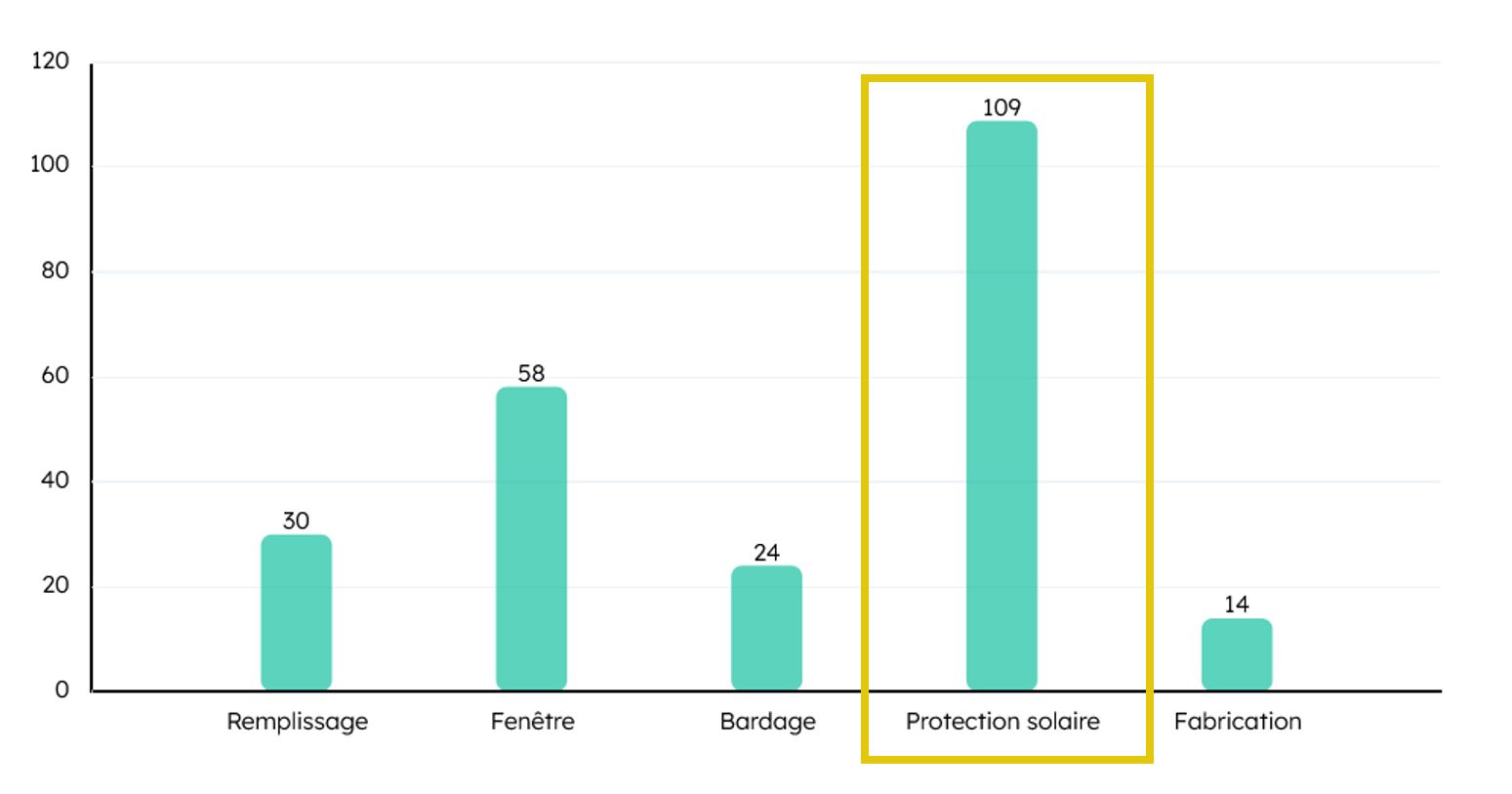Can solar heat gain be reduced while limiting the carbon impact of materials?
Carbon impact is currently a major issue in the construction of building envelopes. This is why Arcora developed ecale.io, a free, online version of its low-carbon design tool (1). Among the multiple functions of an envelope, the solar filtering capacity is paramount for managing thermal and light intake. However, the environmental cost of this protection is far from neutral: it represents between 15% and 50% of the carbon impact of a façade’s manufacturing (2).
Given the multitude of possible typologies (materials, operation, nature), a “tailor-made” approach to the environmental impact of solar shading has been possible since spring 2023 thanks to the DE-baie configurator, proposed by French professional organizations for window and door products and equipment. Following a parametric analysis of data from this configurator, the ecale.io database has been updated to better align with the granularity of this approach.
Comparisons between fabric blinds, Venetian blinds, and shutters, per m² of solar shading, allow us to draw some relevant conclusions shared here:
- Carbon impact variability is very marked: We observe a ratio ranging from 1 to 13 for blinds, specifically between a manual Interior Venetian Blind with a large surface area (19 kg CO2 eq per m² of installed blind, ID VIMX (3)) and a motorized Exterior Fabric Blind with a small surface area (247 kg CO2 eq per m² of installed blind, ID TECS (3)).
[Comparison of dynamic carbon weight (in kg CO2 eq per m² of installed blind) of different types of blinds]
What about shutters? We observe a ratio ranging from 1 to 15 for shutters, specifically between a manual Red Cedar Hinged Shutter with a large surface area (25 kg CO2 eq per m² of installed shutter, ID BRMZ (3)) and a motorized Aluminum Rolling Shutter with a small surface area (374 kg CO2 eq per m² of installed shutter, ID RACS (3)).
[Comparison of dynamic carbon weight (in kg CO2 eq per m² of installed shutter) of different types of shutters]
- What is the best solar shading regarding material carbon impact? The most environmentally efficient blinds at the construction stage are manual interior Venetian blinds with large surface areas. It is noted that for an equivalent surface, a manual blind is always more efficient than a motorized one. However, since impacts can be quite close, a trade-off must be made during design to prioritize equipment with the best environmental performance that aligns with usage.
Wood shutters (EU Wood or Red Cedar) are the most environmentally efficient. Wood is a virtuous material regarding carbon impact, as it consumes CO2 during its growth phase. Red Cedar performs even better than European species because this species has the capacity to store a large amount of carbon.
[Heatmap of the dynamic carbon impact of different types of shutters]
- Large blind surface areas should be favored: The reference surface area has a significant impact on the carbon weight of the solar shading. Implementing “small blinds” (reference surface of 1m²) generates an increase of up to +220% compared to “large blinds” (reference surface of 6m²). This is linked to the constant impact of fixing, control, and potential motorization components, which remain unchanged. This gap widens with motorized operation.
[Heatmap of the dynamic carbon impact of different types of blinds]
These results are expressed in dynamic carbon assessment over 50 years in accordance with the RE2020 regulation. They integrate equipment replacement and provide orders of magnitude on the carbon impact of solar shading during manufacturing and throughout its life cycle.
The implementation of solar shading is often imposed by energy performance criteria—sometimes regulatory—and more broadly by thermal comfort during use. They effectively allow for a reduction in energy consumption during the building’s operational phase. However, given the French electricity emission factor and the efficiency of cooling production, the additional carbon impact generated by constructing solar shading is not always offset by the operational energy gain. The relevance of solar shading—from a carbon impact perspective—must therefore be questioned on a case-by-case basis.
While thermal comfort can be addressed through bioclimatic design, passive solutions, and/or adapted heating and cooling systems, visual comfort makes mobile solar shading indispensable for tertiary uses. Programmatic expectations regarding glare control are high, users are sensitive to ease of use, and environmental certifications remain demanding regarding light intake control. The services rendered by solar shading are multiple, and dissociating functions is a path that may prove relevant, both from the perspective of architecture and usage, and environmental performance.
Footnotes
(1) Dynamic calculation over a 50-year lifespan following the RE2020 method defined by the decree of August 4, 2021.
(2) On the typical example, the impact of solar shading is 48% = 104/214 kg eq. CO₂/m². Excerpt from ecale.io, construction mode “frame in wall,” glazing ratio 50%, collective data for motorized interior Venetian blind (id. FDES INIES 27010).
(3) Values extracted from the DE-BAIE configurator at the date of the article (May 2024). Blind nomenclature:
- T / V: Fabric (Toile) or Venetian
- I / E: Interior or Exterior
- M / C: Manual or Controlled (motorized)
- S / M / L / X / Z: Surface indicator (from S to Z in ascending order)
(4) Values extracted from the DE-BAIE configurator at the date of the article (May 2024). Shutter nomenclature:
- R / B / C: Rolling or Hinged (Battant) or Sliding (Coulissant)
- A / P / B / R: Aluminum or PVC or Wood (EU) or Red Cedar
- M / C: Manual or Controlled (motorized)
- S / M / L / X / Z: Surface indicator (from S to Z in ascending order)






